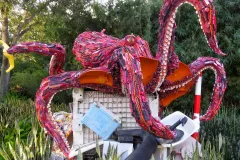Washed Ashore: Art to Save the Sea

While we don't know exactly how much trash is afloat in the ocean, one thing is sure: there's a lot of it. One expedition found up to a ton of garbage per mile on "remote" beaches in Alaska, and it is even accumulating on the deep seafloor. Some of this trash is dumped directly onto beaches or into the ocean. But far more comes from landfills or litter on the street—which is then washed to sea by rainwater via city storm drains and rivers. Most of it is plastic, which can take many years to degrade, harming ocean wildlife that easily confuses it with food. When it does break down, it can release harmful chemicals.
Once the plastic washes back up on the beach, it's fair game for Washed Ashore to use in its sculptures. Angela Haseltine Pozzi is the brain behind the project, designing the sculptures, leading school workshops, and manning the open-house workshops. The sculptures' construction is truly a community effort, with volunteers collecting trash from the beach, cleaning it, sorting it, and then building the sculptures together.
Pozzi tries to portray the diversity of ocean trash in her many sculptures while alluding to other ocean problems. With the help of the community, she's made several large animal sculptures since 2010―over 65 in all. They've made a whale ribcage from white bleach containers, a jellyfish from clear water bottles, and a bleached coral reef from Styrofoam. There is even a musical starfish made from glass bottles that can be played with a mallet. (See slideshow to see some of these sculptures.)
The community effort helps to spread the message that ocean trash is a huge problem—but it has a further symbolic meaning. Just as the sculptures themselves were built by a series of intentional actions by individuals—the trash collection, the plastic washing, the hole drilling, the wire stringing—the plastic got to the beach in the first place because of the individual action of buying a plastic bottle and discarding it improperly. "We really show that every action counts," Pozzi says. "You hear [that line], but I love that you can see that in this project."
What can YOU do to help solve the problem? Reduce your purchases of items wrapped in large amounts of plastic, reuse plastic you do have, and recycle what you can’t use. Use cloth bags and reusable water bottles instead of the throw-away versions. Look for “disposable” packaging that really is disposable―bioplastics that degrade quickly and without releasing toxins. And spread the word about our plastic problem so that others join you in this effort.


